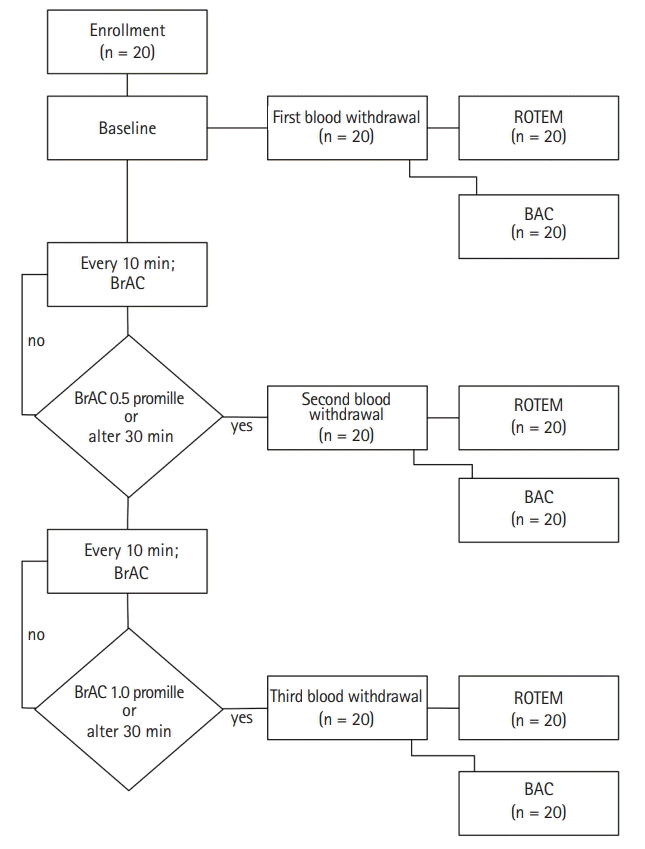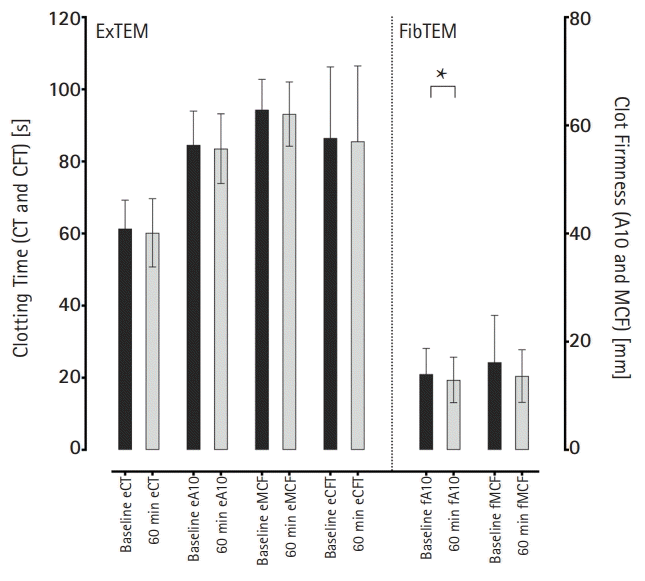1. Hess JR, Brohi K, Dutton RP, Hauser CJ, Holcomb JB, Kluger Y, et al. The coagulopathy of trauma: a review of mechanisms. J Trauma. 2008; 65:748–54.

2. Maier RV. Ethanol abuse and the trauma patient. Surg Infect (Larchmt). 2001; 2:133–41.

3. Spoerke N, Underwood S, Differding J, Van P, Sambasivan C, Shapiro D, et al. Effects of ethanol intoxication and gender on blood coagulation. J Trauma. 2010; 68:1106–11.

4. McAnally HM, Kypri K. Alcohol and road safety behaviour among New Zealand tertiary students. Int J Adolesc Med Health. 2004; 16:229–37.

5. Singleton M, Qin H, Luan J. Factors associated with higher levels of injury severity in occupants of motor vehicles that were severely damaged in traffic crashes in Kentucky, 2000-2001. Traffic Inj Prev. 2004; 5:144–50.

6. Olsen H, Osterud B. Effects of ethanol on human blood fibrinolysis and coagulation. Alcohol Alcohol Suppl. 1986; 1:591–4.
7. Lacoste L, Hung J, Lam JY. Acute and delayed antithrombotic effects of alcohol in humans. Am J Cardiol. 2001; 87:82–5.

8. Serebruany VL, Lowry DR, Fuzailov SY, Levine DJ, O'Connor CM, Gurbel PA. Moderate alcohol consumption is associated with decreased platelet activity in patients presenting with acute myocardial infarction. J Thromb Thrombolysis. 2000; 9:229–34.
9. Haut MJ, Cowan DH. The effect of ethanol on hemostatic properties of human blood platelets. Am J Med. 1973; 56:22–33.

10. de Lange DW, Hijmering ML, Lorsheyd A, Scholman WL, Kraaijenhagen RJ, Akkerman JW, et al. Rapid intake of alcohol (binge drinking) inhibits platelet adhesion to fibrinogen under flow. Alcohol Clin Exp Res. 2004; 28:1562–8.

11. Engström M, Schött U, Reinstrup P. Ethanol impairs coagulation and fibrinolysis in whole blood: a study performed with rotational thromboelastometry. Blood Coagul Fibrinolysis. 2006; 17:661–5.

12. van de Wiel A, van Golde PM, Kraaijenhagen RJ, Borne von dem PA, Bouma BN, Hart HC. Acute inhibitory effect of alcohol on fibrinolysis. Eur J Clin Invest. 2001; 31:164–70.

13. Delahousse B, Maillot F, Gabriel I, Schellenberg F, Lamisse F, Gruel Y. Increased plasma fibrinolysis and tissue-type plasminogen activator/tissue-type plasminogen activator inhibitor ratios after ethanol withdrawal in chronic alcoholics. Blood Coagul Fibrinolysis. 2000; 12:59–66.

14. Erstad BL, Costa CM, Daller JA, Fortune JB. Lack of hematologic effects of recent ethanol ingestion by trauma patients. Am J Ther. 1999; 6:299–302.

15. Charbonney E, McFarlan A, Haas B, Gentilello L, Ahmed N. Alcohol, drugs and trauma: consequences, screening and intervention in 2009. Trauma. 2009; 12:5–12.

16. Plurad D, Demetriades D, Gruzinski G, Preston C, Chan L, Gaspard D, et al. Motor vehicle crashes: the association of alcohol consumption with the type and severity of injuries and outcomes. J Emerg Med. 2010; 38:12–7.

17. Mina AA, Knipfer JF, Park DY, Bair HA, Howells GA, Bendick PJ. Intracranial complications of preinjury anticoagulation in trauma patients with head injury. J Trauma. 2002; 53:668–72.

18. Vavilala MS, Dunbar PJ, Rivara FP, Lam AM. Coagulopathy predicts poor outcome following head injury in children less than 16 years of age. J Neurosurg Anesthesiol. 2000; 13:13–8.

19. Pories SE, Gamelli RL, Vacek P, Goodwin G, Shinozaki T, Harris F. Intoxication and injury. J Trauma. 1992; 32:60–4.

20. Waller PF, Stewart JR, Hansen AR, Stutts JC, Popkin CL, Rodgman EA. The potentiating effects of alcohol on driver injury. JAMA. 1986; 256:1461–6.

21. Bilello J, McCray V, Davis J, Jackson L, Danos LA. Acute ethanol intoxication and the trauma patient: hemodynamic pitfalls. World J Surg. 2011; 35:2149–53.

22. Watson PE, Watson ID, Batt RD. Prediction of blood alcohol concentrations in human subjects. Updating the Widmark Equation. J Stud Alcohol. 1981; 42:547–56.

23. Mitchell MC, Teigen EL, Ramchandani VA. Absorption and peak blood alcohol concentration after drinking beer, wine, or spirits. Alcohol Clin Exp Res. 2014; 38:1200–4.

24. Görlinger K, Jambor C, Dirkmann D, Dusse F, Hanke A, Adamzik M, et al. Platelet function analysis with point-of-care methods. Herz. 2008; 33:297–305.
25. Rainey PM. Relation between serum and whole-blood ethanol concentrations. Clin Chem. 1993; 39:2288–92.

26. Winek CL, Carfagna M. Comparison of plasma, serum, and whole blood ethanol concentrations. J Anal Toxicol. 1987; 11:267–8.

27. Howard BM, Kornblith LZ, Redick BJ, Conroy AS, Nelson MF, Calfee CS, et al. Exposing the bidirectional effects of alcohol on coagulation in trauma: impaired clot formation and decreased fibrinolysis in rotational thromboelastometry. J Trauma Acute Care Surg. 2018; 84:97–103.

28. Wohltmann CD, Franklin GA, Boaz PW, Luchette FA, Kearney PA, Richardson JD, et al. A multicenter evaluation of whether gender dimorphism affects survival after trauma. Am J Surg. 2001; 181:297–300.

29. Napolitano LM, Greco ME, Rodriguez A, Kufera JA, West RS, Scalea TM, et al. Gender differences in adverse outcomes after blunt trauma. J Trauma. 2001; 50:274–80.

30. Basista MH, Joseph A, Smolen S, Koterba A, Brecher AS. Acetaldehyde alters coagulation protein function. Dig Dis Sci. 1994; 39:2421–5.

31. de Gaetano G, Di Castelnuovo A, Rotondo S, Iacoviello L, Donati MB. A meta-analysis of studies on wine and beer and cardiovascular disease. Pathophysiol Haemost Thromb. 2002; 32:353–5.

32. Marmot MG. Alcohol and coronary heart disease. Int J Epidemiol. 2001; 30:724–9.

33. Kaufmann CR, Dwyer KM, Crews JD, Dols SJ, Trask AL. Usefulness of thrombelastography in assessment of trauma patient coagulation. J Trauma. 1997; 42:716–20.

34. Wong CA, Liu S, Glassenberg R. Comparison of thrombelastography with common coagulation tests in preeclamptic and healthy parturients. Reg Anesth. 1995; 20:521–7.
35. Engström M, Reinstrup P, Schött U. An in vitro evaluation of standard rotational thromboelastography in monitoring of effects of recombinant factor VIIa on coagulopathy induced by hydroxy ethyl starch. BMC Blood Disord. 2005; 5:3.

36. Bowbrick VA, Mikhailidis DP, Stansby G. Influence of platelet count and activity on thromboelastography parameters. Platelets. 2003; 14:219–24.

37. Nielsen VG. The detection of changes in heparin activity in the rabbit: a comparison of anti-xa activity, thrombelastography, activated partial thromboplastin time, and activated coagulation time. Anesth Analg. 2002; 95:1503–6.

38. Howard BM, Kornblith LZ, Redick BJ, Vilardi RF, Balhotra KS, Crane JM, et al. The effects of alcohol on coagulation in trauma patients: Interpreting thrombelastography with caution. J Trauma Acute Care Surg. 2014; 77:865–72.
39. Sauaia A, Moore FA, Moore EE, Moser KS, Brennan R, Read RA, et al. Epidemiology of trauma deaths: a reassessment. J Trauma. 1995; 38:185–93.
40. Brohi K, Singh J, Heron M, Coats T. Acute traumatic coagulopathy. J Trauma. 2003; 54:1127–30.

41. Risberg B, Medegård A, Heideman M, Gyzander E, Bundsen P, Odén M, et al. Early activation of humoral proteolytic systems in patients with multiple trauma. Crit Care Med. 1986; 14:917–25.

42. Enderson BL, Chen JP, Robinson R, Maull KI. Fibrinolysis in multisystem trauma patients. J Trauma. 1991; 31:1240–6.







 PDF
PDF Citation
Citation Print
Print




 XML Download
XML Download